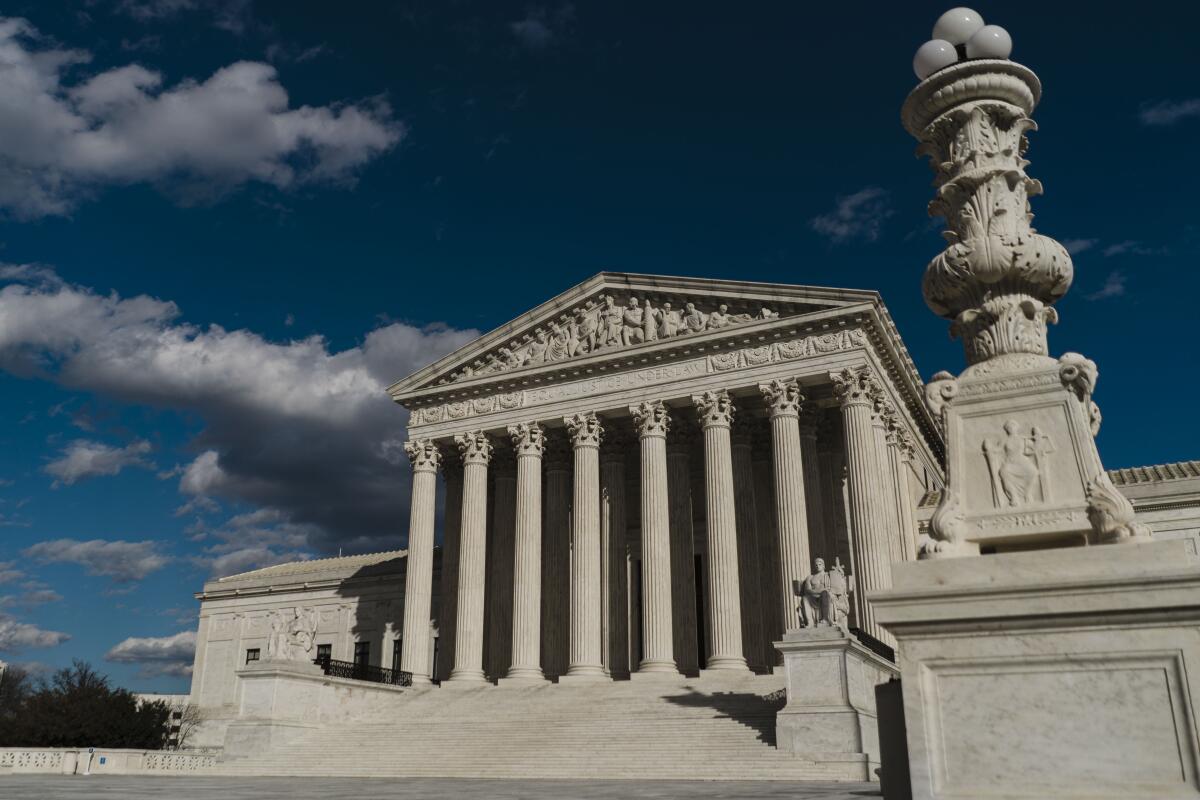Supreme Court upholds Voting Rights Act in surprise ruling against Alabama Republicans

- Share via
WASHINGTON — The Supreme Court upheld the broad reach of the Voting Rights Act on Thursday, ruling that Alabama’s Republican lawmakers are required to draw a new election district that would likely elect a Black Democrat to Congress.
In a 5-4 vote that surprised voting rights advocates, the justices rejected an appeal from Alabama Republicans and reaffirmed the principle of fair representation for racial and ethnic minorities.
The outcome could bolster Democrats in Republican strongholds across the South and potentially tilt control of the closely divided House of Representatives.
Writing for the court, Chief Justice John G. Roberts Jr. said Congress had amended the Voting Rights Act in 1982 to ensure that Black voters were not denied an equal opportunity to “elect representatives of their choice.” The voting power of Black people would be “diluted” and made meaningless if nearly all districts can be drawn to preserve white majorities, civil rights advocates said.
Six of Alabama’s seven congressional districts reliably elect Republicans, although about 27% of the state’s population is Black. Last year, a panel of three judges said the state could easily draw a second compact and “reasonably configured” district that a Black candidate could win.
Joining Roberts to affirm that decision were Justices Sonia Sotomayor, Elena Kagan, Brett M. Kavanaugh and Ketanji Brown Jackson.
Thursday’s ruling in Allen vs. Milligan could have significant political impact, particularly across the South, from Georgia and Florida to Texas. These Republican-led states have resisted drawing more voting districts that would likely result in the election of more Democrats. The court’s ruling will bolster legal claims that these election maps deny fair representation for Black or Latino people.
Given how closely divided the House of Representatives currently is, the decision could even shift control of the chamber, said David Wasserman, the U.S. House expert at the nonpartisan Cook Political Report. In addition to Alabama, new district lines could be drawn in Louisiana, South Carolina and Georgia and lead to the “creation of 2-4 new Black-majority districts, netting [Democrats] 2-4 seats,” he tweeted.
The decision also applies to election districts for state legislatures, county boards and city councils.
Voting rights advocates hailed the ruling as a major victory, not because it expanded the law but because a conservative high court voted to preserve it.
Alabama Republicans had argued it was unconstitutional to draw new districts along racial lines.
The National Redistricting Foundation, an affiliate of the National Democratic Redistricting Committee, called the decision a “massive win for voting and for voters across the country. Black voters in Alabama have long been denied fair representation — and today’s Supreme Court decision in favor of voters marks a landmark moment to move the needle in the right direction,” said Marina Jenkins, the group’s executive director.
The decision came as a surprise in part because Roberts has been a longtime critic of the Voting Rights Act.
As a young lawyer in the Reagan administration, he opposed the 1982 amendments on the grounds that they would lead to “proportional representation” based on race.
He also led the court 10 years ago in overturning a key provision of the Voting Rights Act that had required Alaska, Arizona, seven Southern states and certain other jurisdictions to obtain clearance from Washington before making changes in voting rules or election laws. In a 5-4 decision in Shelby County vs. Holder, Roberts said this special burden was no longer justified.
In Thursday’s ruling, he said the court was not seeking to change the law but to maintain it. He said “a faithful application of our precedents and a fair reading of the record before us” shows that Alabama must draw an extra district that could elect a Black candidate.
Since the 1980s, he said, the court has held that states must draw one or more districts that favor Black or Latino candidates when certain conditions are met. Those conditions include whether there are enough Black or Latino people to make up a voting district that would be “compact” and “reasonably configured.” Another factor is whether voting is “racially polarized.” Lawyers said that in Alabama, no Black candidate had a chance of winning in a white-majority district.
Last year, the three-judge panel applied those standards and ruled that the state must redraw its map to create a second compact, near-majority Black district. The judges, including two appointed by former President Trump, said the Voting Rights Act required giving Black voters a meaningful opportunity to elect a representative of their choice.
But last year, in a preliminary win for the GOP, the Supreme Court blocked that decision from taking effect.
Then, Kavanaugh voted with four other conservative justices to block the creation of the new district.
But the court agreed to review the case and hear arguments on the law. Kavanaugh then cast a deciding vote to join Roberts and the court’s three liberals to affirm the lower-court ruling.
More to Read
Get the L.A. Times Politics newsletter
Deeply reported insights into legislation, politics and policy from Sacramento, Washington and beyond. In your inbox three times per week.
You may occasionally receive promotional content from the Los Angeles Times.











